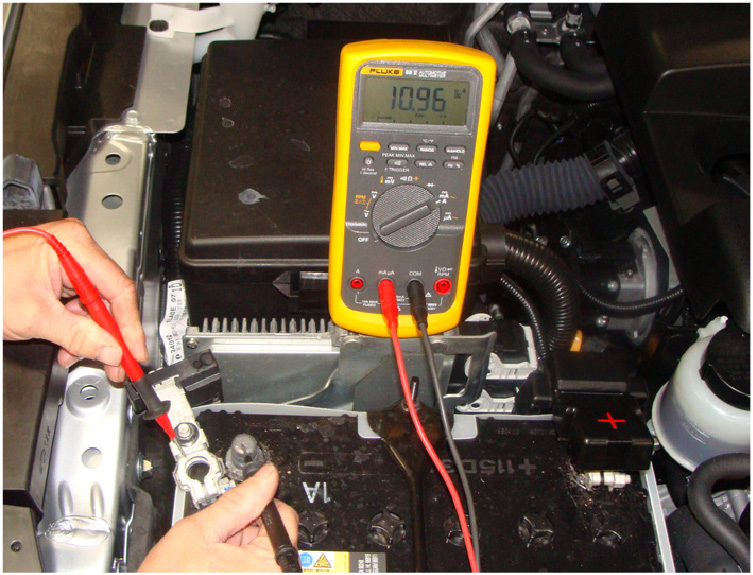Measuring Parasitic Draw
All vehicles draw some power from their batteries when the car is shut off. Vehicles with onboard computers have Random Access Memory (RAM). And accessories such as clocks, audio systems (station presets), seats (Automatic Drive Positioner, or ADP), remote door openers, and security systems also need power to maintain memory when the ignition is OFF. Each device with memory has a different amount load. The power used as a result of this continuous energy or cumulative load is called parasitic draw. It is usually a very small draw so the battery doesn’t become drained. Parasitic loads can run 20 to 120 milliamps. If there is an electrical short in the vehicle or a malfunctioning accessory it could draw more than its normal load causing a large drain on the battery.
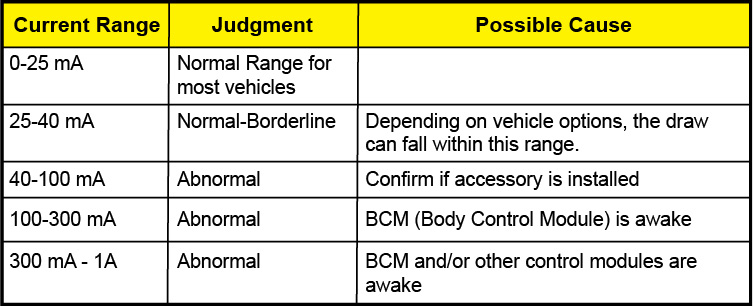
In order to check for parasitic draw, a Digital Multi-Meter (DMM) that can handle a minimum of one milliamp and up to 10 amps is needed to perform a parasitic draw test.
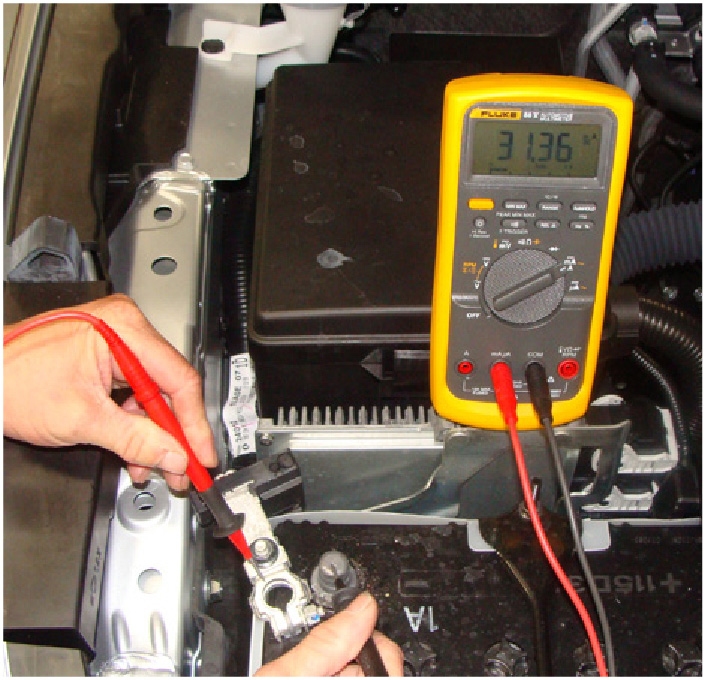
Vehicle Preparation
1. First prepare the vehicle for the parasitic draw test by making sure the battery is charged. Weak batteries don’t give accurate results when performing a draw test. In addition to diagnosing and charging a weak battery (or if you installed a new one to replace a dead one) make sure to verify that the charging system is operating properly.
2. Turn the ignition OFF, and then make sure all electrical accessories are OFF, too. This includes unplugging anything plugged in a power socket(s).
3. Disconnect the electrical connector for the Anti-Theft System Hood Switch (if equipped).
4. Close the Hood.
5. Operate the vehicle to simulate customer operation. Run the engine, drive the vehicle, stop the engine, release the hood latch, exit and lock the vehicle.
6. Digital Volt Ohm Meter (DVOM) Preparation (refer to the operating instructions provided with meter).
a. Set DVOM to measure DC Amps on the highest scale (usually 10A).
b. Move the DVOM red lead to the Amps position in the meter.
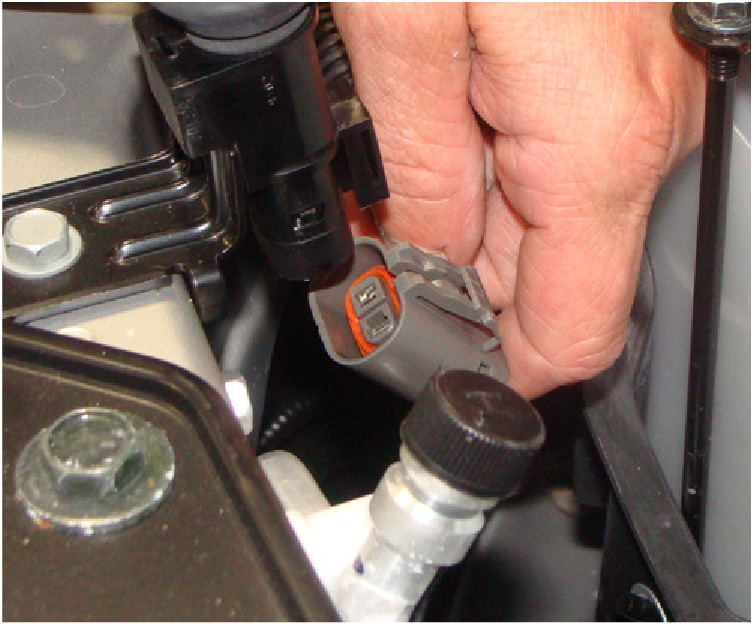
Vehicle Preparation for Measurement
1. Open the Hood.
2. Wait at least 60 minutes to allow all systems to enter sleep mode. To get a correct reading, the vehicle should be left with the doors closed and the ignition OFF for an hour before beginning the test.
3. Select Ammeter, and then connect the leads.
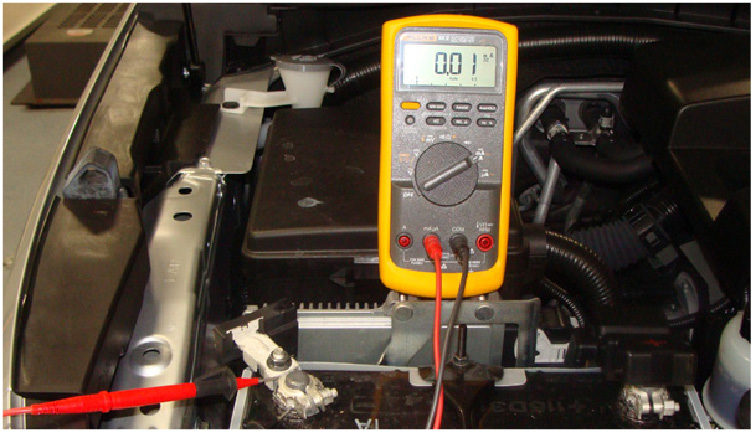
The most difficult part of making a parasitic draw measurement is establishing a “shunt” connection through your DVOM prior to disconnecting the terminal cable from the negative battery post.
a. Loosen, but Do Not remove the negative battery terminal.
b. Connect the red lead to the negative battery cable end.
c. Connect the black lead to the negative battery post.
4. Carefully remove the negative battery cable without breaking the shunt connection while removing the terminal cable from the battery post. Make sure the DVOM leads remain attached to the battery post and cable end. It’s imperative that you keep this connection to avoid sending one of the modules back into an initialization process which boosts current flow. This may not blow the meters fuse, but it will definitely give you an incorrect reading. You will have to wait until that process completes and they are ready to go to sleep before you can try again. The Ammeter should then be able to give you an accurate Parasitic Draw (Dark Current) measurement.
Note: General Specification Guidelines
0.00 – 0.022 Amps (0 – 22 mA) = OK
> 0.023 Amps (> 23 mA) = NG*
* Actual values will vary by model and option content. Confirm with a like-option content vehicle to verify reading if necessary.
Determining the Source of Parasitic Draw
If the ammeter reading exceeds 23 mA, something may be using too much power. If excessive parasitic draw is present it will need to be corrected so the battery does not drain. To determine the source of Parasitic Draw (Dark Current), start by checking for aftermarket accessories. If any aftermarket accessories are present, remove the power to these accessories, and then retest.
Finally, follow normal diagnostic procedures to identify source of draw. If you have a high reading, you’ll need to check each component. For example, remove fusible links, fuses, relays, etc., one at a time until the draw is isolated to the offending electrical component/system. Open the door, and tape the door switch open circuit so that the system returns to sleep mode. Then, remove each fuse one at a time to isolate the circuit causing the draw.
The under hood fuses can be removed without too much difficulty, and without waking up the BCM. If you can’t identify an excessive draw by removing the fuses, and the components check out fine, you may have a wiring problem.
